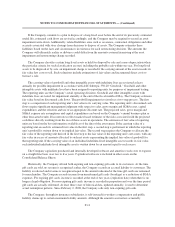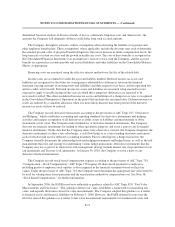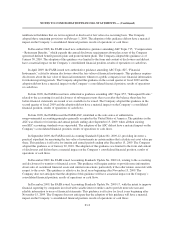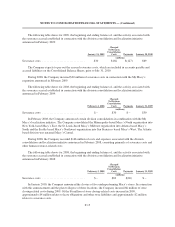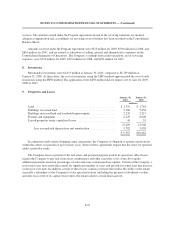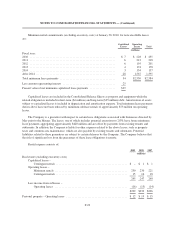Macy's 2009 Annual Report Download - page 66
Download and view the complete annual report
Please find page 66 of the 2009 Macy's annual report below. You can navigate through the pages in the report by either clicking on the pages listed below, or by using the keyword search tool below to find specific information within the annual report.
NOTES TO CONSOLIDATED FINANCIAL STATEMENTS — (Continued)
the Company’s reporting units failing the first step of the goodwill impairment test. The Company then
undertook the second step of the goodwill impairment test, which involved, among other things, obtaining third-
party appraisals of substantially all of the Company’s tangible and intangible assets. Based on the results of its
goodwill impairment testing as of January 31, 2009, the Company recorded a pre-tax goodwill impairment
charge of $5,382 million ($5,083 million after income taxes) in the fourth quarter of 2008. As a result of the 2008
goodwill impairment charge, Macy’s is the only retail operating division with goodwill.
Based on the results of the most recent annual impairment test of goodwill and indefinite-lived intangible
assets completed during the second quarter of 2009, the Company determined that goodwill and indefinite-lived
intangible assets were not impaired as of May 30, 2009 and the estimated fair value of the Macy’s reporting unit
substantially exceeded its carrying value.
The goodwill impairment testing process involves the use of significant assumptions, estimates and
judgments by management, and is subject to inherent uncertainties and subjectivity. Estimating a reporting unit’s
discounted cash flows involves the use of significant assumptions, estimates and judgments with respect to a
variety of factors, including sales, gross margin and SG&A rates, capital expenditures, cash flows and the
selection and use of an appropriate discount rate. Projected sales, gross margin and SG&A expense rate
assumptions and capital expenditures are based on the Company’s annual business plan or other forecasted
results. Discount rates reflect market-based estimates of the risks associated with the projected cash flows of the
reporting unit directly resulting from the use of its assets in its operations. The allocation of the estimated fair
value of the Company’s reporting units to the estimated fair value of their net assets also involves the use of
significant assumptions, estimates and judgments. Both the estimates of the fair value of the Company’s
reporting units and the allocation of the estimated fair value of the reporting units to their net assets are based on
the best information available to the Company’s management as of the date of the assessment.
The use of different assumptions, estimates or judgments in either step of the goodwill impairment testing
process, including with respect to the estimated future cash flows of the Company’s reporting units, the discount
rate used to discount such estimated cash flows to their net present value, the reasonableness of the resultant
implied control premium relative to the Company’s market capitalization, and the appraised fair value of the
reporting units’ tangible and intangible assets and liabilities, could materially increase or decrease the fair value
of the reporting unit and/or its net assets and, accordingly, could materially increase or decrease any related
impairment charge.
5. May Integration Costs
On August 30, 2005, the Company completed the acquisition of The May Department Stores Company
(“May”) (the “Merger”). The Company added about 400 Macy’s locations nationwide in 2006 as it converted the
regional department store nameplates acquired through the Merger. In conjunction with the conversion process,
the Company identified certain store locations and distribution center facilities to be divested.
Following the Merger, the Company announced its intention to sell the acquired Lord & Taylor division and
the acquired May bridal group business, which included the operations of David’s Bridal, After Hours
Formalwear and Priscilla of Boston. The sale of the Lord & Taylor division was completed in October 2006, the
sale of David’s Bridal and Priscilla of Boston was completed in January 2007 and the sale of After Hours
Formalwear was completed in April 2007. See Note 6, “Discontinued Operations,” for further information. As a
result of the Company’s disposition of the Lord & Taylor division and bridal group businesses, these businesses
were reported as discontinued operations.
May integration costs represent the costs associated with the integration of the acquired May businesses
with the Company’s pre-existing businesses and the consolidation of certain operations of the Company. The
F-18





